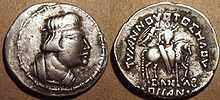Heraios

Obv: Bust of Heraios, with Greek royal headband.
Rev: Horse-mounted King, crowned with a wreath by the Greek goddess of victory Nike. Greek legend: ΤΥΡΑΝΝΟΥΟΤΟΣ ΗΛΟΥ - ΣΑΝΑΒ - ΚΟϷϷΑΝΟΥ "The Tyrant Heraios, Sanav (meaning unknown), of the Kushans".

 | ||||||||||||||||||||||||||||||||||||
| History of Afghanistan | ||||||||||||||||||||||||||||||||||||
|---|---|---|---|---|---|---|---|---|---|---|---|---|---|---|---|---|---|---|---|---|---|---|---|---|---|---|---|---|---|---|---|---|---|---|---|---|
| Timeline | ||||||||||||||||||||||||||||||||||||
|
Ancient
|
||||||||||||||||||||||||||||||||||||
|
Medieval
|
||||||||||||||||||||||||||||||||||||
|
Modern
|
||||||||||||||||||||||||||||||||||||
| ||||||||||||||||||||||||||||||||||||
Heraios (often read as Heraus, Heraos, Miaos) was a clan chief of the Kushans (reign: 1-30 CE), one of the five constituent tribes of the Yuezhi confederacy in Bactria in the early 1st century CE, roughly at the time when the Kushans were starting their invasion of India.
Silver coins were made in the Hellenistic style and used the Greek writing. The reverse shows the winged Greek god of victory Nike holding out a wreath over the clan chief mounted on a horse. The clan chief wears a tunic and has a large bow on the side. The portrait shows Heraios with a marked artificial skull deformation, a characteristic of several Kushan portraits and sculptures of the 1st century CE.
On the coins, the clan chief's name appears as "ΗΛΟΥ" or ""ΗΙΛΟΥ", which has been variously transliterated as "Ilou", "Maou" or "Miaou".
| Preceded by: In Bactria, Yuezhi ruler: Sapadbizes |
Kushan Ruler (1-30 CE) |
Succeeded by: Kujula Kadphises |
References
External links
- A Comparison of Images of Kushans from Coins and Sculpture
- Kushan Empire coins
- Coins of Heraios
- Catalogue of Heraios coins